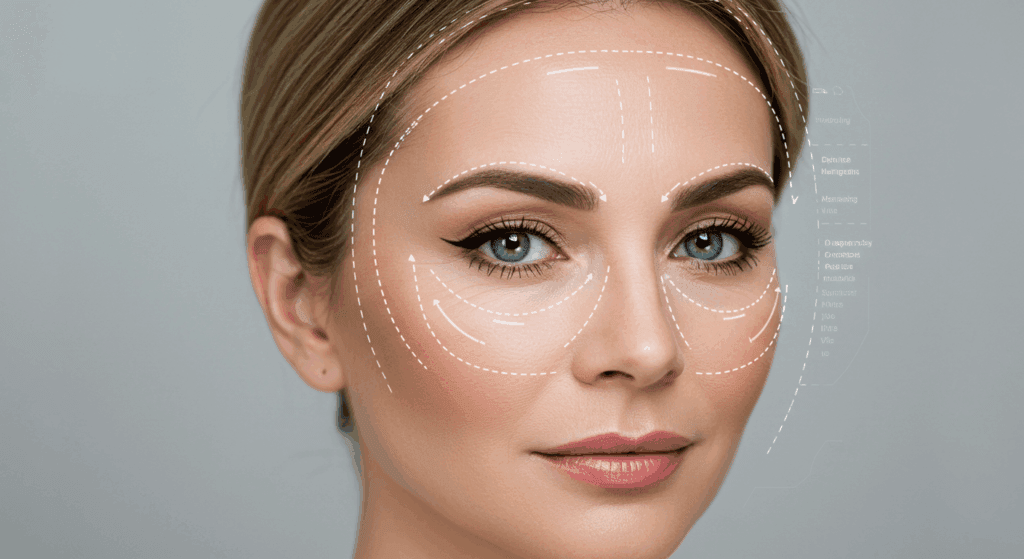Have you noticed how some celebrities seem to age gracefully, maintaining a natural, refreshed look without the telltale signs of “work done”? Enter the deep plane facelift, a sophisticated surgical technique that’s revolutionizing facial rejuvenation in 2025 by targeting deeper layers for more authentic and enduring results. Unlike traditional facelifts that primarily tighten the skin, a deep plane facelift repositions the underlying muscles and connective tissues, addressing the root causes of sagging for a harmonious, youthful appearance that can last 10-15 years or more. With advancements in minimally invasive approaches and enhanced recovery protocols, this procedure has seen a 20% surge in popularity, particularly among those aged 40-65 seeking subtle enhancements.
This complete surgical guide demystifies what is deep plane facelift, from its anatomical foundations to step-by-step processes, recovery tips, and considerations for medical tourism options like Antalya’s premium clinics. Drawing on the latest insights from authoritative sources such as the American Society of Plastic Surgeons (ASPS) and recent 2025 studies, we’ll explore everything you need to know, including “deep plane facelift vs traditional” and “deep plane facelift recovery time.” Whether you’re a UK resident eyeing cost-effective excellence abroad or simply curious about this innovative option, this article provides evidence-based education to empower your decisions. As always, consult a board-certified surgeon for personalized guidance, as individual results vary based on health and anatomy.

Table of Contents
Foundational Understanding of Deep Plane Facelift
A deep plane facelift is an advanced rhytidectomy technique that delves beneath the superficial musculoaponeurotic system (SMAS)—a layer of fibrous tissue enveloping facial muscles—to reposition deeper structures, including muscles and fat pads, for comprehensive rejuvenation. This method contrasts with superficial facelifts by lifting the skin and SMAS as a composite unit, reducing tension on the skin and minimizing the “pulled” look often associated with older procedures. The goal is to restore natural facial contours, smoothing nasolabial folds, jowls, and marionette lines while preserving expressive mobility.
Prevalence has grown significantly; in 2025, deep plane facelifts account for over 40% of all facelift surgeries in the U.S., with similar trends in Europe and Turkey, driven by patient demand for longevity and subtlety. Demographically, it’s favored by middle-aged professionals, with women comprising 85-90% of patients, though men are increasingly opting in for defined jawlines. In urban hubs like London or Antalya, high-income individuals pursue it to align outer appearance with inner vitality.
Historically, the deep plane approach was pioneered in the 1990s by surgeons like Sam Hamra, evolving from SMAS plication techniques to address mid-face descent more effectively. By 2025, innovations include hybrid integrations with threads or lasers, as seen in presentations at AMWC conferences, enhancing outcomes with reduced downtime. Recent developments emphasize safety, with systematic approaches cutting operative time to 2-3 hours and complication rates to under 3% in experienced hands.
Fundamentally, it works by countering gravitational aging: Post-40, ligaments weaken, causing tissue ptosis; the surgery releases these, repositions, and secures for elevation. A 2025 systematic review of 300 cases showed superior mid-face volume restoration compared to traditional methods, with patients appearing 8-10 years younger. Misconceptions include fears of extensive scarring—incisions are hidden in hairlines—or that it’s overly invasive; in reality, it’s tailored for natural results, debunking the “windblown” myth through layered dissection.
This foundation underscores why deep plane facelifts are ideal for moderate to advanced aging, offering a balanced alternative in the spectrum of facial procedures.
Clinical Aspects: Anatomy and Aging in Deep Plane Context
Facial aging in the deep plane context arises from multifactorial causes: Intrinsic genetics reduce collagen by 1% annually after 30, while extrinsic factors like UV exposure (responsible for 80% of visible changes) and smoking accelerate elastin breakdown. Pathophysiologically, the SMAS and retaining ligaments lax, leading to fat compartment descent and bone resorption, manifesting as hollow cheeks and jowls by the 40s-50s.
Signs include deepened nasolabial folds, marionette lines, and neck banding, often graded via scales like the Merz Aesthetics Scale (0-4 severity). Risk factors—obesity, poor skincare—exacerbate these, with studies linking high BMI to 15% increased ptosis.
Stages of aging relevant to deep plane: Early (40s, mild laxity) may suit mini versions; moderate (50s) requires full dissection; advanced (60s+) combines with adjuncts like fat grafting. A 2025 study highlights hormonal influences in women, with menopause speeding mid-face drop by 20%.
Common misconceptions: Deep plane isn’t “deeper” risk-wise—nerve injury rates are similar (1-2%) to superficial when performed by experts. Another: It only lifts the lower face; actually, it excels in mid-face elevation, as per 2025 guidelines.
Clinically, analogies help: Think of the face as a tent—deep plane tightens the poles (muscles) rather than just the canvas (skin), ensuring stability.
Diagnostic Approach: Evaluating for Deep Plane Facelift
Candidacy assessment starts with consultations screening for health issues like uncontrolled diabetes, which raises infection risks by 10%. Physical exams evaluate skin elasticity, bone structure, and asymmetry via pinch tests and measurements.
Diagnostic tests include blood work, EKGs for over-50s, and 3D imaging to visualize outcomes, interpreting fat distribution and ligament integrity. Differential diagnoses exclude non-surgical mimics like allergies causing puffiness.
Psychological screening addresses expectations, as 10% of seekers have unrealistic goals. In 2025, AI tools predict aging progression, aiding decisions.
For international patients, virtual consults precede in-person, ensuring suitability.
Management Strategies: Surgical Techniques and Alternatives
Deep plane facelifts involve general anesthesia, lasting 2-4 hours: Incisions along hairline/ears, dissection below SMAS, ligament release, tissue repositioning upward, excess skin trim, and closure with sutures. Mechanism: Composite lift reduces skin tension, promoting natural healing.
Variations: Extended for neck inclusion; hybrid with threads for multiplane enhancement, as in Dr. Berat Çiğdem’s techniques. Alternatives: Traditional SMAS plication (shorter recovery but less durable); non-surgical like fillers (temporary, 1-2 years).
Lifestyle: Pre-op quit smoking; post-op UV avoidance preserves results. Preventive: Skincare delays needs.
Monitoring: Follow-ups at 1 week, 1/3/6 months, with photos.

Practical Considerations: Living Post-Deep Plane Facelift
Post-surgery, daily life resumes gradually: Swelling peaks day 3-5, 80% resolved by week 2-3; return to work in 10-14 days. Impact: Avoid exercise 4-6 weeks; numbness fades in months.
Support: Forums, apps for tracking; costs £8,000-£20,000 UK, £4,000-£7,000 Antalya packages. Insurance excludes cosmetics.
In Antalya, Dr. Çiğdem’s clinic offers all-inclusive with nursing, ideal for UK tourists.
Special Populations in Deep Plane Facelifts
Geriatrics (65+) need cardiac eval, with adjusted techniques for thinner skin. Pregnancy contraindicates; wait postpartum.
Comorbidities: Manage hypertension pre-op. Men: Thicker skin allows robust lifts.
Diverse: Tailor for ethnic scarring risks.
Deep Plane vs. Other Facelifts: Key Comparisons
Deep plane excels in longevity (12-15 years) vs. traditional (7-10), with natural mid-face lift. Mini: Quicker but superficial.
Comparison Table: Facelift Types
| Aspect | Deep Plane | Traditional | Mini |
|---|---|---|---|
| Depth | Below SMAS | Skin/SMAS | Superficial |
| Duration | 12-15 years | 7-10 years | 5-7 years |
| Recovery | 2-3 weeks | 1-2 weeks | 1 week |
| Ideal For | Moderate aging | General | Early signs |
When to See a Doctor and Questions to Ask
Consult if sagging affects confidence; post-op for unusual swelling.
Questions: “Deep plane vs. others?” “My recovery timeline?” “Risks for me?”
Key Takeaways Box:
- Targets deep layers for natural, long results.
- 2025 innovations: Faster recovery, hybrids.
- Ideal 40-65; consult certified surgeons.
- Antalya options: Affordable premium care.
Conclusion
The deep plane facelift stands as a pinnacle of 2025’s surgical artistry, offering a complete solution to facial aging by addressing deeper structures for authentic, lasting rejuvenation. From its anatomical precision and step-by-step execution to tailored recovery and considerations for diverse patients, this guide illuminates why it’s a game-changer, backed by recent advancements showing superior outcomes over traditional methods. For UK seekers, destinations like Antalya—with experts like Dr. Berat Çiğdem providing ISAPS-backed, all-inclusive experiences—make premium care accessible. Embrace informed choices: Reflect on your goals, consult professionals, and step forward confidently toward a revitalized you, always prioritizing safety and personalization.
References
- What Is a Deep Plane Facelift? | 2025 Guide by Dr. Williams. Retrieved from https://www.williamsfacialsurgery.com/blog/what-is-deep-plane-facelift/
- How is a deep plane facelift done – Athena Plastic Surgery. Retrieved from https://athenaplasticsurgery.com/deep-plane-facelift-complete-guide/
- Deep Plane Facelift Recovery Guide – Boris M. Ackerman, M.D. Retrieved from https://www.doctorackerman.com/blog/deep-plane-facelift-recovery-guide/
- Facelift Surgery Guide | The American Board of Cosmetic Surgery. Retrieved from https://www.americanboardcosmeticsurgery.org/procedure-learning-center/face/facelift-guide/
- Preparing for a Deep Plane Facelift: A Comprehensive Guide | BLOG. Retrieved from https://rodriguezfelizmd.com/blog/preparing-for-a-deep-plane-facelift-a-comprehensive-guide/
- Systematic Approach to Deep Plane Facelift | Aesthetic Plastic Surgery. Retrieved from https://link.springer.com/article/10.1007/s00266-025-04793-0
- Facelift Innovations 2025: Smarter Techniques & Recovery | Tampa. Retrieved from https://www.drdemetrimd.com/blog/discover-2025s-amazing-breakthrough-facelift-innovations/
- Facelift 2025: Ultimate Guide to Beauty | San Antonio. Retrieved from https://findyourbeautiful.com/blog/facelift/
- Guide To Deep Plane Facelift – Dr. Markarian | Boston. Retrieved from https://plasticsurgeryofboston.com/guide-to-deep-plane-facelift/
- Your Guide to the Deep-Plane Facelift – Chernoff Cosmetic Surgery. Retrieved from https://chernoffcosmeticsurgery.com/blog/your-guide-to-the-deep-plane-facelift/

